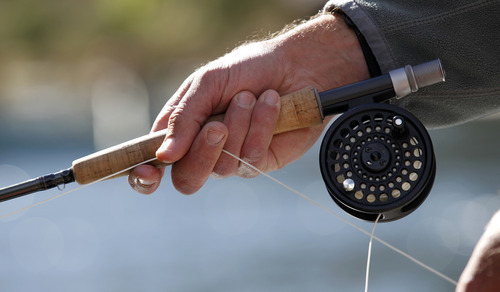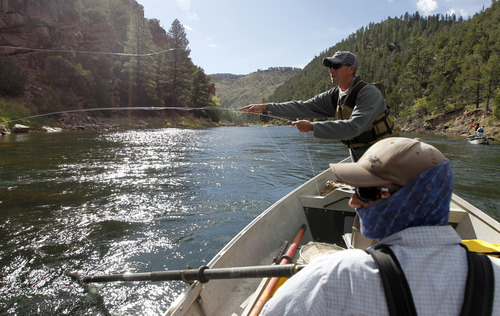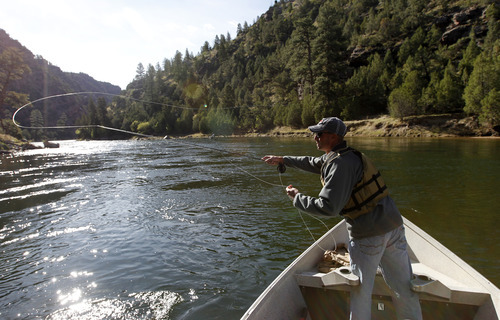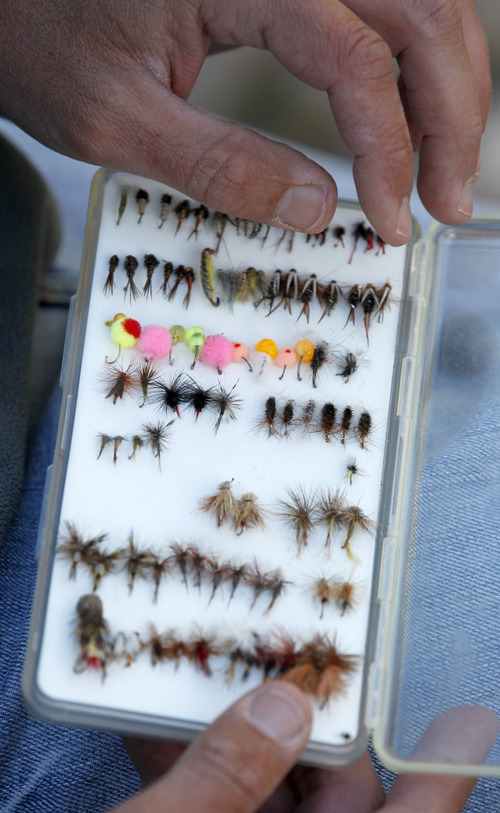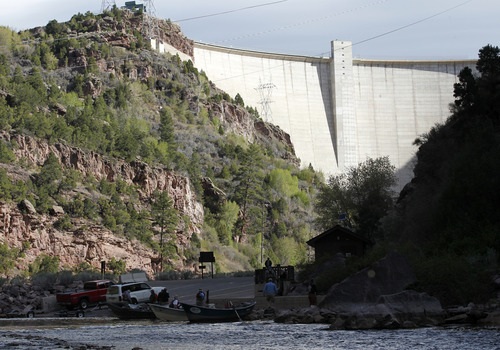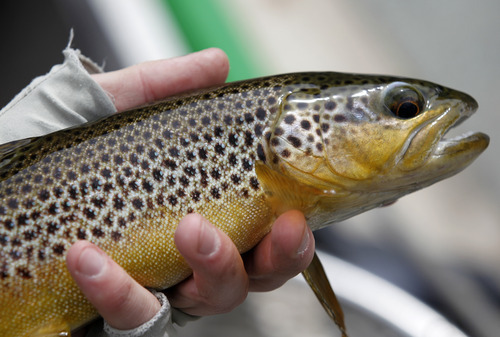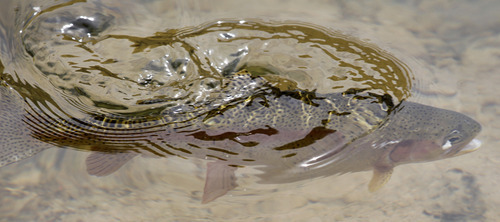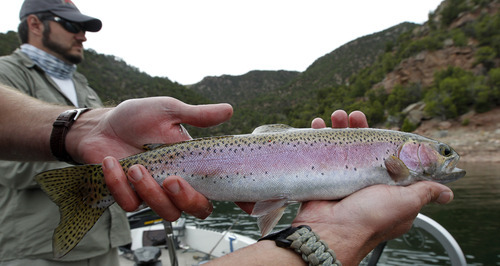This is an archived article that was published on sltrib.com in 2012, and information in the article may be outdated. It is provided only for personal research purposes and may not be reprinted.
Dutch John • Rivers, like people, need medicine at times to fight off that nagging cold or annoying rash. So what remedy helped the Green River below Flaming Gorge Dam when it was feeling blue?
A flush.
Flows shot up last spring to nearly 9,000 cubic feet per second for more than a month, cleansing the tailwater fishery and putting the blue-ribbon water back in the business of producing one of the planet's best trout-fishing experiences.
Thanks to Soggy Spring 2011, anglers can look forward to Year of the Rainbow 2012.
"It has been fantastic," said Kevin Clegg, a river guide for Flaming Gorge Resort and member of the Green River Outfitters and Guides Association. "The fish are in great condition. The aquatic bug life is the best we have seen in many years. The hatches are bigger, the bugs are bigger and the fish are getting bigger. There are a lot of happy anglers. I'm really looking forward to the rest of the year."
Utah fisheries biologists had asked the Bureau of Reclamation for five- to seven-day flows of 8,600 cubic feet per second. Nature delivered — to the benefit of rainbow and brown trout. The wet winter of 2010-11 also helped the trout fishery above the Green.
"High water covers vegetation and creates a lot more habitat and nutrients," explained Ryan Mosley, Flaming Gorge project leader for the Utah Division of Wildlife Resources. "Our zooplankton reading was 60 percent greater last year than it was in the previous years. That benefits the entire fishery."
Fishing reports on Flaming Gorge have been very good for rainbow trout. Many anglers focus on species such as lake trout, kokanee salmon and smallmouth bass when headed to the Gorge, but few know the reservoir has become prized territory for rainbow.
Ryan Kelly, a fly-fishing guide on the Green and resident of nearby Dutch John, heads for the Gorge with his young family for fast and tasty fishing each spring.
"This is the perfect eating size," says Kelly, holding up a 14- to 15-inch fish, one of the 70 or so rainbow he landed on a recent three-hour outing. "We like to pull up on one of the campgrounds here and take a couple and cook them up on the coals. You can catch a boatload of these and they are great fighters. I thought I had a marlin; I was chasing him all over."
Biologists have yet to confirm officially that a heavy influx of water in 2011 has boosted the fishing, but expect to find plump trout and kokanee salmon when they conduct annual spring gill-netting surveys.
Below the dam, biologists were thrilled with the results of the annual two-night spring electroshocking survey in mid-April. In fact, the only complaint was that there were too many flying insects, making it impossible to talk without ingesting a mouthful of protein.
"We have had reports that hatches this spring have been of far greater magnitude than any other spring in recent memory, including abundant hatches of midges, mayflies and stoneflies," DWR fisheries biologist Matt McKell reported. "And healthy bug populations are, of course, good for the fish."
Biologists and guides had been trying to find a way to get a major spring flow like the one in 1999, which released between 10,000 and 11,000 cubic feet per second. Surveys by Utah State University showed a positive effect on the river's invertebrate life.
DWR officials ended up requesting a flow of 8,600 cubic feet, protecting Forest Service boat ramps, restrooms and the seven-mile Little Hole Trail, which stretches from the dam to the Little Hole Day Use Recreation Area.
Nature stepped in, loading Wyoming's Wind River Mountains, headwaters of the Green, with plenty of snow last year. Reclamation officials at Flaming Gorge Dam kept an eye on the levels in May 2011 and decided to start letting water out of the reservoir before water in the mountains arrived.
That did the trick.
"Mayfly numbers are quadruple to numbers just prior to the high flows," McKell said. "Scuds are double and midges and true flies are about the same as the long-term average. The fish are healthy and chubby and in good shape. We are looking forward to a really good year of fishing."
Because the rainbow trout along the Green and in the Gorge are so healthy this spring — and still readily hitting lures and flies despite all the available food — Mosley and McKell have deemed 2012 the Year of the Rainbow.
That seems appropriate. After all the rains and snows — and flows — a huge rainbow was bound to show up. It just took a year. —
Fishing the Gorge and the Green
O See a video and gallery about fishing the Flaming Gorge National Recreation Area in 2012 › http://youtu.be/7TLISfiZuTQ .
Then check out videos from previous years on gill netting for lake trout at Flaming Gorge › http://www.youtube.com/watch?v=WXi1Bt8TcCE and fly-fishing on the Green River. › http://www.youtube.com/watch?v=cQiVY6w90_8 —
How to go for rainbow in spring
These techniques and patterns — courtesy of Ryan Mosley, Flaming Gorge project leader for the Utah Division of Wildlife Resources — should work until the reservoir surface temparatures climb into the 60s, typically in mid- to late June, and rainbows move to deeper, cooler water. Then it's a matter of adjusting to the rainbow's behavior, which means fishing much deeper. Of course, with the unseasonably high temps, adjustments may come a couple of weeks earlier.
Spinning gear — Lots of lure choices out there. Fish with what you have the most confidence in. Jigs such as curly tails, tubes and hair jigs in earth tones and 1/4- to 3⁄8-ounce weights work well. Cast toward shore and jig back to the boat. Many of the hits come on the drop, so keep a tight line. Lighter lines work better, especially fluorocarbons, which are nearly invisible in the clear waters. Crankbaits, spoons and spinners can also be effective in the spring.
Fly-fishing gear — These change as conditions change. Wooly buggers work well for shallow rainbows but, depending on the day and the air temperature, terrestrial patterns will also work, such as ants, crickets and hoppers. Midge hatches are common at the reservoir, allowing for both dry fly and nymph opportunities. If spawning rainbows are located, you can go with fish egg patterns and an all-time favorite, the egg-sucking leech.
Trolling gear — Small spoons, dodger/squid combos and pop gear in vibrant colors work well. Troll shallow (10 to 20 feet) at about 1.5 to 2 mph and close to shore, where spring rainbows lurk. Tip lures with Gulp maggots or eggs, meal worms and night crawlers for further enticement. It's not uncommon to catch kokanee and lake trout using the same tactics.
Bait gear — Nothing beats a nightcrawler/marshmallow combo for shore fishers. Try adding a bobber to help young anglers identify strikes.
These river techniques come from Ryan Kelly, guide from Flaming Gorge Resort:
Nymph Rigs: All fished below indicators. With all nymph rigs attaining the desired depth is the biggest challenge for most anglers. As a rule of thumb, on suspended rigs, the distance between the indicator and flies should be twice that of the desired depths. If you want to fish 4 feet deep, make the length 8 feet.
Tandem Rig - Two similarly sized beadheads together by attaching the second fly off the bend of the hook. Great for suspended fish.
Dredge/Bounce Rig - Weights are put on the bottom of the line with two flies above attached by dropper lines. This rig keeps the flies on the bottom at all times and facilitates easy hook sets. Great for less skilled anglers.
Dropper Below - Use a large fly and drop a small fly below. his works great for picky fish as the large fly peaks curiosity and the fish eats the more natural imitation while he's there.
Dropper Above- Use a heavy large fly on the bottom of the line with a smaller fly above. This keeps the flies close to the bottom and a tighter line between indicator and flies. This works great in high water.
Streamer Rig - Pick your favorite streamer and add a smaller fly as a trailer. We dead drift this rig a lot, but I love to swing it through seems as well. This is a great late summer/fall nymph rig on the green.
Dry Fly Rigs:
Tandem Flies - Use an easy to see fly on the first and the natural imitation on the second. This works great with a trailing emerger as well. Great for blue wings, midging, or anytime smaller flies are used.
Single Fly - Self explanatory. Put your favorite fly on and keep it afloat.
Dry/Dropper - Use a bigger dry fly, such as a cicada and drop a weight fly, such as a zebra midge 1-5 feet below. This is the most common rig I use over the course of the year.
Flies for Spring:
Gulper Special #16-20
Adams #16-20
BWO Cripple #14-18
Green River Parabaetis #16-20
Midge Emergers #18-24
Fuzzball# 18-24
Midge emerger trailing shuck#18-24
Tiny midge patterns. 22-30
JuJu Baetis #16-18
Tung Stud Black #16-18
Neon Nightmare Pink or Orange #6-8
Gray, Red, Black, Olive WD40 and WD50 #16-22
Wine, Black, Rainbow or Purple Zebra Midge #14-22
Gray Soft Hackle #16-22
Ginger Woolly Bugger #6-8
Ginger Bunny #6-8
Pheasant Tail #14-22
Gigaglow —
How to go for rainbow in spring
These techniques and patterns — courtesy of Ryan Mosley, Flaming Gorge project leader for the Utah Division of Wildlife Resources — should work until the reservoir surface temparatures climb into the 60s, typically in mid- to late June, and rainbows move to deeper, cooler water. Then it's a matter of adjusting to the rainbow's behavior, which means fishing much deeper. Of course, with the unseasonably high temps, adjustments may come a couple of weeks earlier.
Spinning gear — Lots of lure choices out there. Fish with what you have the most confidence in. Jigs such as curly tails, tubes and hair jigs in earth tones and 1/4- to 3⁄8-ounce weights work well. Cast toward shore and jig back to the boat. Many of the hits come on the drop, so keep a tight line. Lighter lines work better, especially fluorocarbons, which are nearly invisible in the clear waters. Crankbaits, spoons and spinners can also be effective in the spring.
Fly-fishing gear — These change as conditions change. Wooly buggers work well for shallow rainbows but, depending on the day and the air temperature, terrestrial patterns will also work, such as ants, crickets and hoppers. Midge hatches are common at the reservoir, allowing for both dry fly and nymph opportunities. If spawning rainbows are located, you can go with fish egg patterns and an all-time favorite, the egg-sucking leech.
Trolling gear — Small spoons, dodger/squid combos and pop gear in vibrant colors work well. Troll shallow (10 to 20 feet) at about 1.5 to 2 mph and close to shore, where spring rainbows lurk. Tip lures with Gulp maggots or eggs, meal worms and night crawlers for further enticement. It's not uncommon to catch kokanee and lake trout using the same tactics.
Bait gear — Nothing beats a nightcrawler/marshmallow combo for shore fishers. Try adding a bobber to help young anglers identify strikes.
These river techniques come from Ryan Kelly, guide from Flaming Gorge Resort:
Nymph Rigs: All fished below indicators. With all nymph rigs attaining the desired depth is the biggest challenge for most anglers. As a rule of thumb, on suspended rigs, the distance between the indicator and flies should be twice that of the desired depths. If you want to fish 4 feet deep, make the length 8 feet.
Tandem Rig - Two similarly sized beadheads together by attaching the second fly off the bend of the hook. Great for suspended fish.
Dredge/Bounce Rig - Weights are put on the bottom of the line with two flies above attached by dropper lines. This rig keeps the flies on the bottom at all times and facilitates easy hook sets. Great for less skilled anglers.
Dropper Below - Use a large fly and drop a small fly below. his works great for picky fish as the large fly peaks curiosity and the fish eats the more natural imitation while he's there.
Dropper Above- Use a heavy large fly on the bottom of the line with a smaller fly above. This keeps the flies close to the bottom and a tighter line between indicator and flies. This works great in high water.
Streamer Rig - Pick your favorite streamer and add a smaller fly as a trailer. We dead drift this rig a lot, but I love to swing it through seems as well. This is a great late summer/fall nymph rig on the green.
Dry Fly Rigs:
Tandem Flies - Use an easy to see fly on the first and the natural imitation on the second. This works great with a trailing emerger as well. Great for blue wings, midging, or anytime smaller flies are used.
Single Fly - Self explanatory. Put your favorite fly on and keep it afloat.
Dry/Dropper - Use a bigger dry fly, such as a cicada and drop a weight fly, such as a zebra midge 1-5 feet below. This is the most common rig I use over the course of the year.
Flies for Spring:
Gulper Special #16-20
Adams #16-20
BWO Cripple #14-18
Green River Parabaetis #16-20
Midge Emergers #18-24
Fuzzball# 18-24
Midge emerger trailing shuck#18-24
Tiny midge patterns. 22-30
JuJu Baetis #16-18
Tung Stud Black #16-18
Neon Nightmare Pink or Orange #6-8
Gray, Red, Black, Olive WD40 and WD50 #16-22
Wine, Black, Rainbow or Purple Zebra Midge #14-22
Gray Soft Hackle #16-22
Ginger Woolly Bugger #6-8
Ginger Bunny #6-8
Pheasant Tail #14-22
Gigaglow


